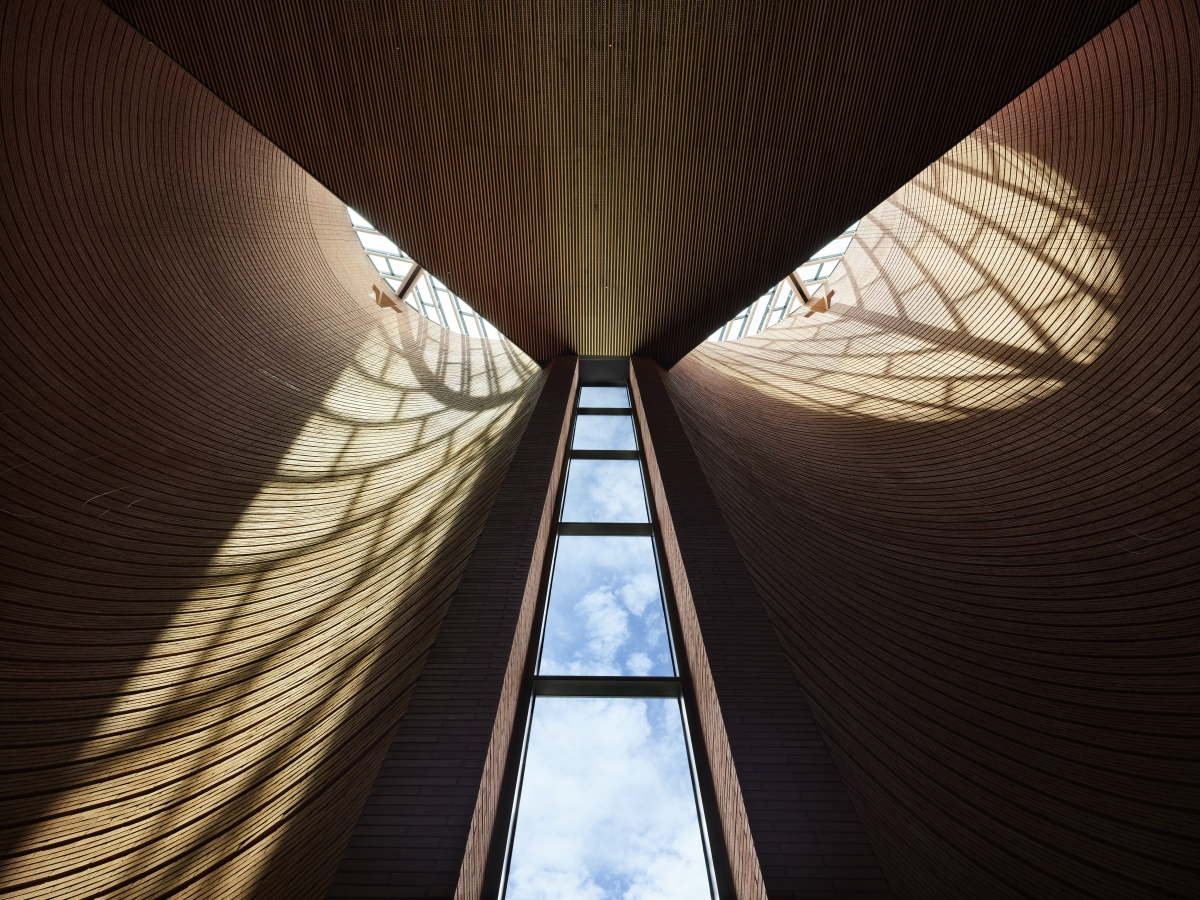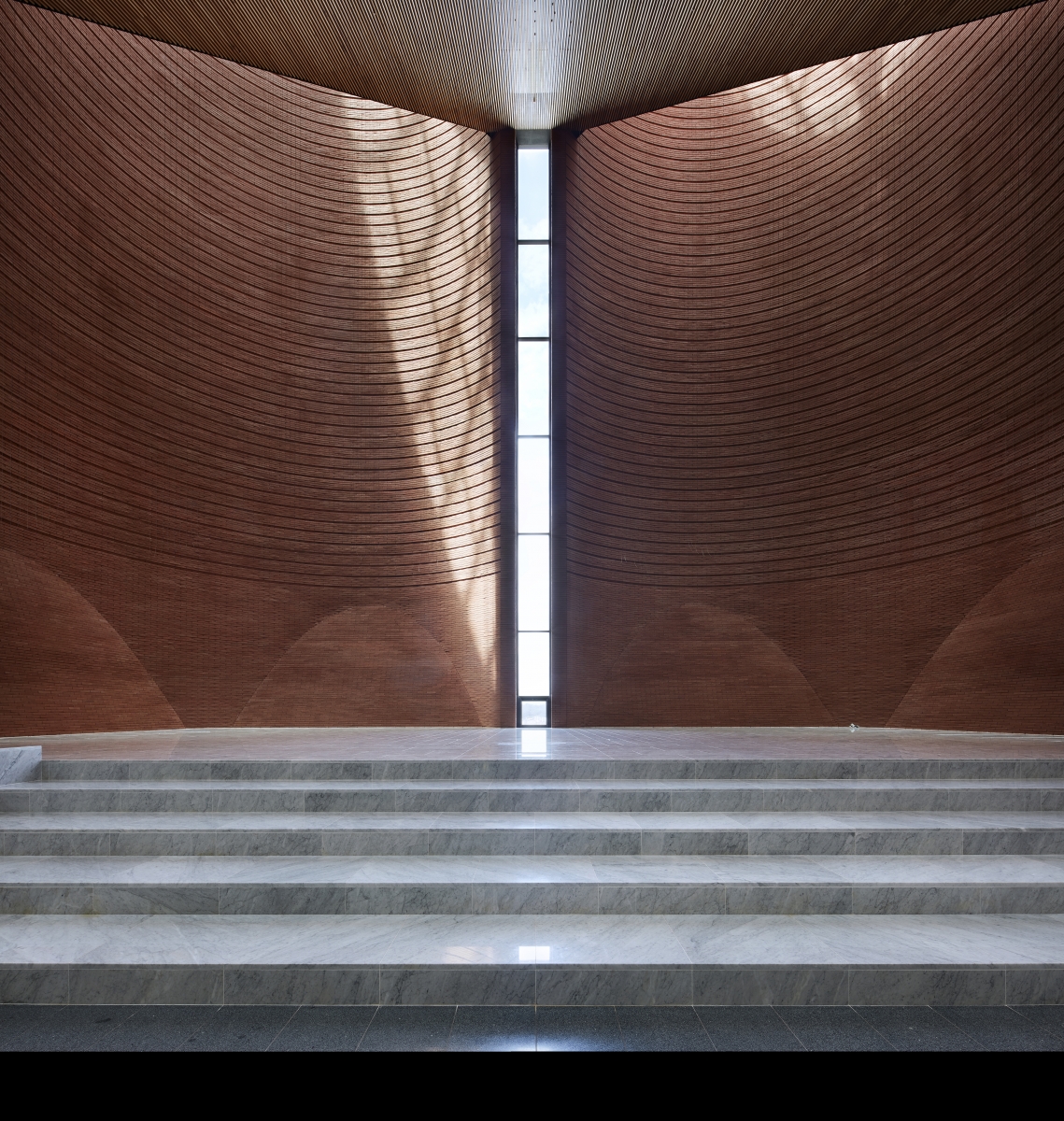
ⓒKim Yongkwan

ⓒKim Yongkwan
‘What does this figure signify?’ – We ask the question by habit. Like this, our attitude toward a figure is tied to semantics. However, this attitude resulted from reductive application of standards of linguistics and semiotics to architectural forms. The question should be changed. It is required to be redirected from ‘what does it signify’ to ‘what does it do?’. When we get out of the stone well of semantics and move to practical and ethical realm, a more accurate understanding of the figure can be achieved. In this sense, Mario Botta’s the Church of Our Lady of the Rosary of Namyang seems fresh. The cathedral managed to construct a figure with a power which is vivid, moving, effective, attractive, and magical rather than with an activity on the horizon of shallow semantics. The 41m-tall red twin towers towards the sky! They are the mast that catches all eyes who enters the precincts, and the focal point that overlooks the whole site. It is a source of energy to revive even a tired body suddenly. A sky obscured by dark clouds, a land exposed in the open yard in front of outdoor altar, the horizon of canopy, and intervening forest—they could emerge floating with a presence thanks to the construction of the towers. Despite their physical distance and intervals of construction timeline between the buildings, the towers are the keystone that embodies the condensed ensemble of the ‘present’.
In fact, the geometrical form of a cylinder cut diagonally is frequently used in his works. But it still seems novel rather than manneristic. Standing in the site of martyrdom, the upright figure that far exceeds the scale of a megalith! First, the twin towers seem to refuse to be read as belonging to any specific religion. The presence of the cross is deliberately kept low-key. It is only timidly engraved on the top side of the cylinder. Instead of emphasizing a clear identity, it shows the weakness of deliberate adoption of ambiguous attitudes. But they stand firm. It is reinforced by the fact that they are twin towers. Though they tried to erase religious identity, they express their presence itself even more clearly. Two qualities coexist here. They are ambiguous but clear, weak but strong.
The way into the cathedral along a carefully devised sacred route leads to the two towers as the apses at the end. The sequence starts with the towers that were the focus of the precincts, and after entering the cathedral, ends up standing in front of the tower again. The moment of this last encounter is surprising. It reveals unique presence of the figure. A slit between the two towers provides a vertical, strong light. It creates a line of light along the center of the smooth floor. Twin manifestations of horizontal and vertical lines, or the identical light on the floor and in front of eyes at the same time! On a sunny day, light is extended down to the altar through the skylight above the tower, turned to the southeast and southwest. Rectangular pattern of the skylight creates a marvelous metamorphosis when it meets the curved surface inside the circular tower. The shadows cast by stiff straight mullions on the curved surface look like enlarged patterns of dragonfly’s curved wing. A golden wingbeat! Just like the position of Louis I. Kahn, whom Botta looks up to his teacher, the intervention of natural light created a lively variation that even Botta could not have predicted. When I visited the cathedral at the end of August, I could see just short spell of sunshine as it was rainy. It was a pity that I could not see the golden wingbeat, but the light falling on the altar via the tower was warm and gentle. Apses of a mild atmosphere welcomed a visitor who was led to the altar along the line of light without fear! Since the half of lower arcs of the two towers were cut, the exposed part of inner curved surface appeared to give me a hug with open arms. The soft twin curved surfaces with a diameter of more than 10m seem to have generosity to embrace not only me but many people at the same time. The towers have more than just the light. They also serve as a wind way. It is a wind tower where the indoor air can escape to the outside through the window on the top. The altar is surrounded by warm light and cool breeze. All of this is a tribute to the towers. Phenomenal ‘presence’ of light has been a constant theme in cathedral architecture. In fact, light hides itself in ‘fullness’ in everyday life just like air does. To make light that does not reveal itself emerge was an important theme of architecture. I come up with Abbot Suger’s Basilique de Saint-Denis which replaced thick walls of apse and cloister in Romanesque cathedral with thin column, pointed arch, and rib vault to allow light to emerge. Abbot Suger’s dream of light dates back to Pseudo Dionysius Areopagite, a mystic of the Byzantine Empire of more than seven centuries ago, which was the birthplace of Hagia Sophia’s light. His philosophy of light is impressive. Weaving the phenomenal lumen that is ever changing and tactile and the divine lux that is invisible and intangible, he said that the former is a metaphor for the latter. In a similar vein, Augustine of Hippo said that the temporality given by ever changing phenomenal light is the image of eternity. To cope with humid atmosphere of Osaka, Ando Tadao allowed light to appear by darkness, polished concrete like glass surface, and a slit window on the south façade in his Church of the Light, which is an important example of capturing light in contemporary church history. Botta’s cathedral leaves another milestone. Despite its name which means ‘sunshine of the south,’ the light of Namyang is difficult to deal with. It is different from the light of the Mediterranean that clearly shows its presence. This is largely due to moisture. Nevertheless, Botta successfully handles this tricky light to make it emerge. Here is one more attractive fact. The towers whose bottom arc is cut in half! They create a ‘posture’ that embrace people with their arms wide open. It is a combination of a warm light and a generous attitude. Botta says that architecture doesn’t need fancy technology to be impressive.
According to critics like Sigfried Giedion, who provided contemporary critics with the basis of the prejudices, Botta’s position may sound outdated. To keep pace with the progress of art and science, architecture must step forward. Architects must have an understanding of cubism and stroboscope, and, like Walter Gropius, they have to design Bauhaus Dessau in Germany. A decent architect should be able to mention the Fourth Industrial Revolution, and talk about architecture designed by datascape and artificial intelligence. But Botta asks back. Does the fact that technology has completely changed force architecture to change accordingly? This attitude misunderstands the different roles that technology and architecture play in culture and falls into the fallacy of technology reductionist. A ‘situation’ can be created only by stacking layers working in different time zones. In the stacking of layers that seem to have not changed at all, layers that change constantly, and intermediate layers between the two extremes, even brilliant advances in technology can be revealed as ‘change’ or ‘difference’. The Church of Our Lady of the Rosary of Namyang states that cathedral and architecture can’t function properly in contemporary culture without restoring the efficacy of the figure. It goes beyond banal semantics and enters the realm of practice by investigating the source of the figure. Cutting the top of cylindrical figure at 45 degrees, and half of the arc at the bottom which is exposed to the interior, it creates a figure of ‘action’ rather than that of ‘signification’. Ambiguity to erase the identity, soaring strength, warm light, cool breeze, and generous attitude! The corporeality of the figure is revived. (written by Baek Jin / edited by Kim Yeram)
Baek Jin
Baek Jin graduated from Seoul National University (B.S.), Yale University (M.A.), and the University of Pennsylvania (Ph.D.). Before joining the Department of Architecture and Architectural Engineering, Seoul National University, he taught and researched at various institutions including Pennsylvania State University and the University of Tokyo. He is the author of Nothingness: Tadao Ando’s Christian Sacred Space (Routledge, 2009), Architecture as the Ethics of Climate (Routledge, 2016) and Punggyeongryuheang (Hyohyung, 2013).
48





